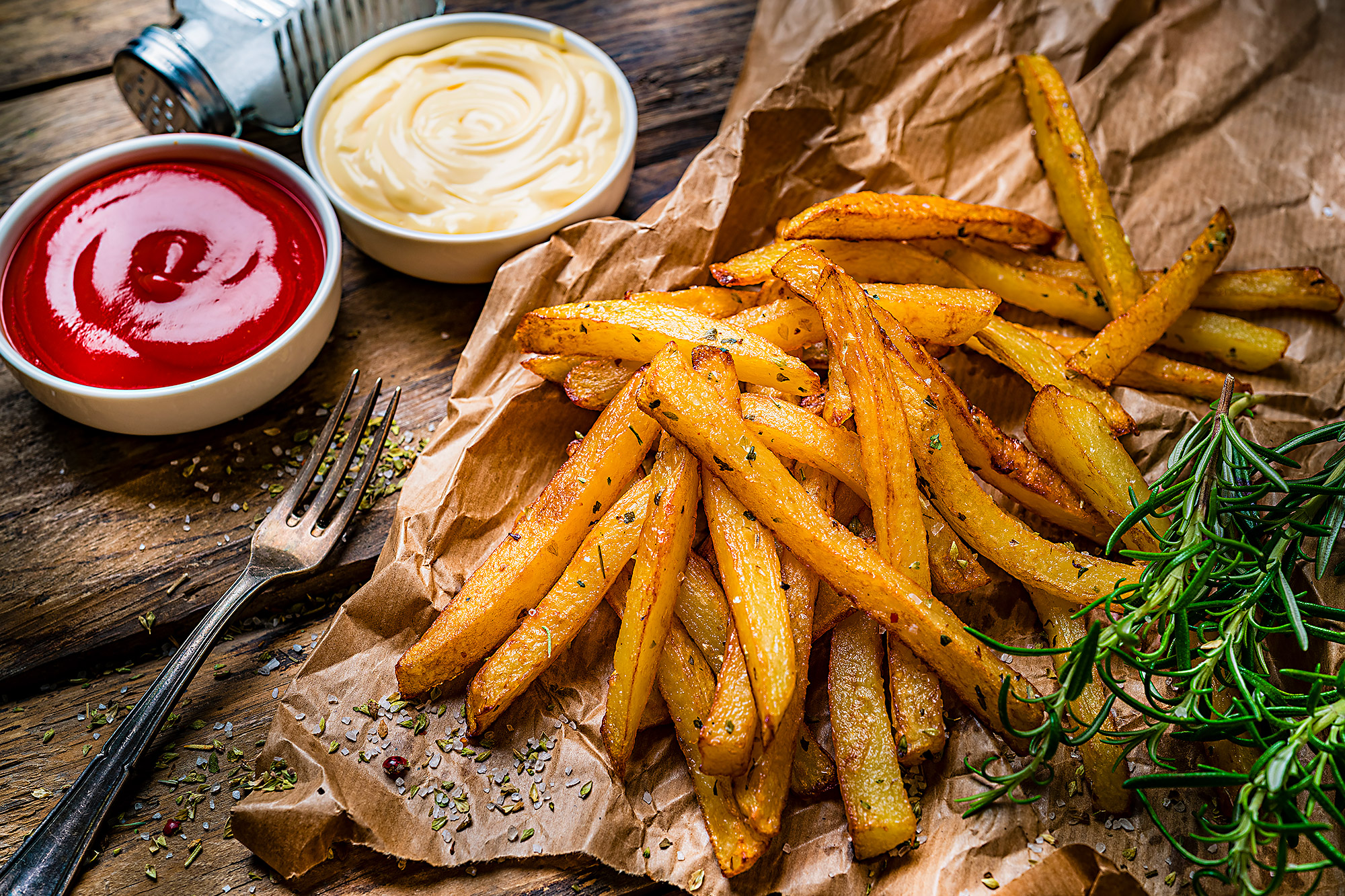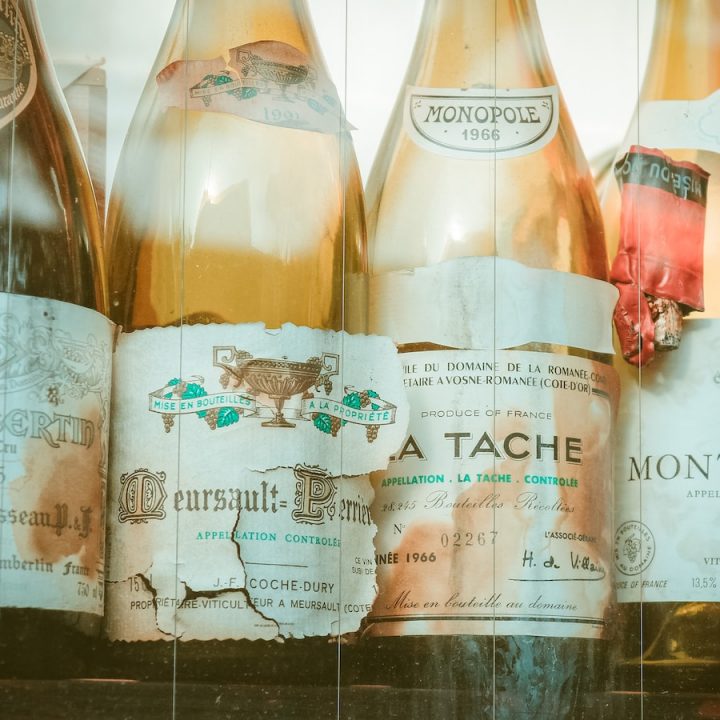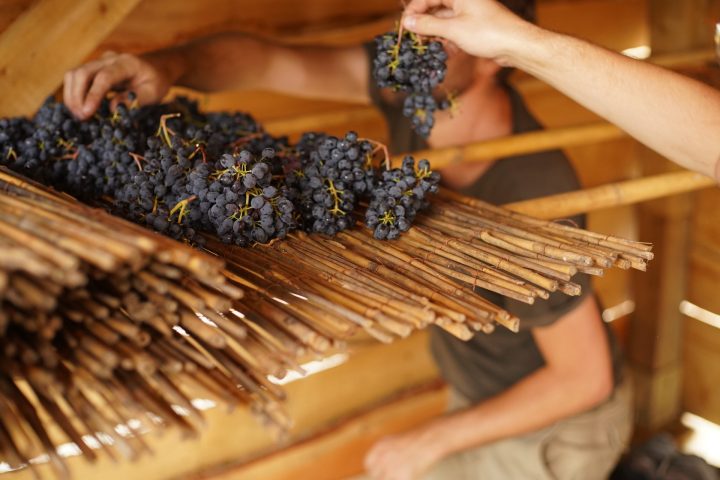For many, French fries are the epitome of unhealthy junk food, but how many calories the tasty potato sticks have depends largely on how they are prepared. Deep-fried in plenty of hot fat, they soak up oil and become delicious calorie bombs. If you prepare your fries in the oven or hot air fryer, on the other hand, they are much healthier and still delicious.
The beauty of homemade fries is the simplicity of their preparation. With just a few ingredients, you can prepare crispy fries in no time, whether in the oven, the pot or the deep fryer. In this guide, you’ll learn everything you need to know to make your homemade fries a success and to do away with ready-made frozen fries in the future.
The characteristics of perfect fries
What makes a good portion of French fries and how can you recognize them? This is a question that frit lovers around the world have been asking for decades, and many of the characteristics you read and hear about are more subjective in nature. It’s up to you whether you prefer the intense flavor of beef fat, prefer to use unpeeled potatoes, or how thick or thin you like your French fries. But there are also objective characteristics that must meet any good fries.
Good fries …
- … have a golden brown color.
- … are crispy on the outside and creamy-tender on the inside.
- … are reasonably uniform.
- … were well seasoned, but are not too salty.
- … do not break when pulled through the dip.
Who invented the French fries?
Probably the French, because “pommes de terre frites” is French and means “fried potatoes”. However, it could also have been the Belgians, because French is spoken here as well. In fact, both nations firmly believe that their country is the birthplace of French fries.
In France, the legend circulates that the crispy potato sticks were already a popular snack at the time of the French Revolution in 1789. Belgium’s claim as the place of origin of French fries is based on a recipe that proves the existence of the deep-fried potato sticks as early as the 17th century. According to this, the tasty fast food was especially appreciated in winter and served as a substitute for fish when the rivers froze over and fishing was no longer possible. As today, they were deep-fried in hot fat even in those days.[/vc_column_text][vc_column_text]
The best variety of potatoes for fries
Choosing the right potato is crucial to making perfect fries, and not every variety is suitable. Connoisseurs know that the best fritters are made from firm-boiled or predominantly firm-boiled potato varieties. These can withstand the high heat during preparation without becoming brittle and breaking. Some predominantly floury varieties can also be used for preparation, but require a little more care so that they do not fall apart. Whether fries are made from waxy or floury potatoes is easy to figure out when you eat them. Firm-cooking varieties provide a creamy mouthfeel, while flourier varieties have a more airy, dry interior.
Nobody likes small fries – really nobody! Therefore, make sure that you reach for a variety with the largest possible tubers.
Recommended varieties are:
- Lady Rosetta (roundish and medium sized tubers)
- Sorba (very large tubers, therefore very popular in gastronomy, but difficult to obtain).
- Bintje (large tubers, potato of the year 2012)
- Agria (large, uniform tubers)
- Yukon Gold (very heat resistant with uniform, large tubers).
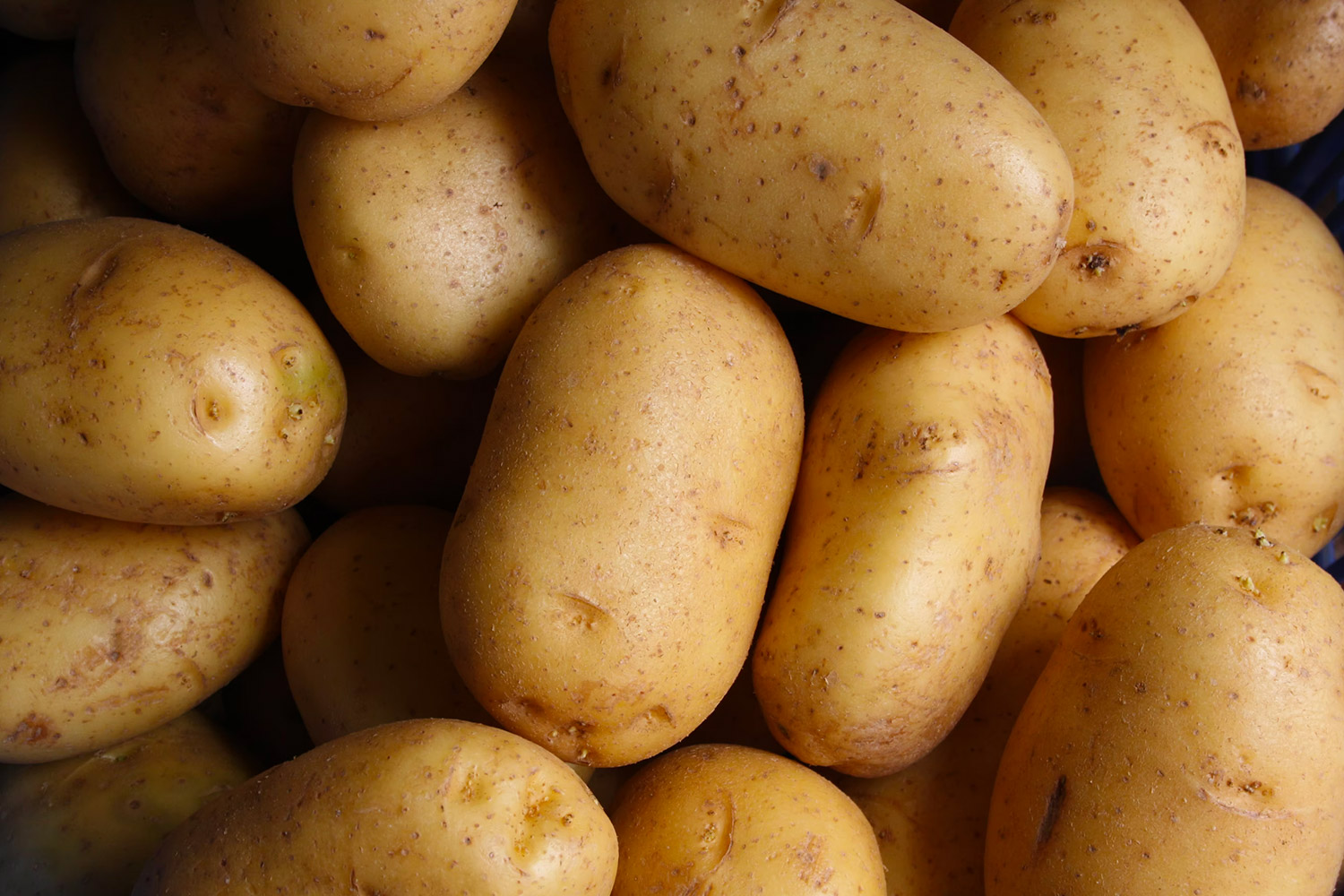
With or without shell?
Whether you leave the skin on the potatoes or peel them first depends on your preference and choice of potato variety. For varieties with thick skin, you should apply the peeler, otherwise the skin can become somewhat tough during frying. In most cases, however, you can skip this step and leave the pellet on. This will give your homemade fries a more rustic look.
Prepare the potatoes properly
Whether your fries turn out merely good or great also depends on how much time you invest in preparation. To get crispy pencils, you need to follow some rules. But do not worry, the preparation is not too difficult.
Cut the tubers into uniform sticks
For your homemade fries, cut the potatoes into even strips. The thickness of the fries directly influences their subsequent taste. Thicker sticks over 1 cm remain much juicier on the inside, but require a slightly longer time when frying for the first time until they are cooked. Thinner fritters cook faster, but are more likely to be dry.
Be sure to water potatoes or …
After you cut your fries, you should put them in a large pot or bowl and cover them with cold water. This separates the starch from the potatoes, which would prevent a crispy crust when deep-frying. Pour off the cloudy water directly, fill up with new water and leave the pens in the water for half an hour.
After that, you need to dry your fries thoroughly. For best results, first rub them dry with a towel and then let them air dry completely again. Believe me, it’s worth the effort.
… blanch in vinegar water
If you ask experts, they agree: the best results are obtained when you blanch the ready-cut sticks again for 10 minutes in vinegar-water. To do this, add a dash of vinegar to the water. The short and hot bath makes the starch dissolve better from the sticks, while the low pH from the vinegar strengthens the potato cells, making them more stable. This is partly because the pectin contained in potatoes is more effective in acidic environments. However, due to the short time, the vinegar only acts on the surface, which ensures that your fries get an extra crispy crust.
Rice flour makes your fries really crispy
After you’ve soaked and dried your raw fries, you can dust them with rice flour before frying. The reason: The flour extracts the remaining moisture from the pencils. The drier your fries, the crispier they will be. However, I recommend that you give your fries some time in the air and let them dry naturally. This way you can save on the rice flour.
The best fat for delicious fries
Most fries are deep-fried in heat-resistant vegetable oil with a high smoke point. Refined rapeseed oil, sunflower oil or peanut oil are mainly used here.
In Belgium, one of the two possible birthplaces of the delicious potato sticks, they rely on pure beef fat. This gives them a meaty flavor and makes them a real taste explosion.
Since I fry almost exclusively with canola oil in my kitchen, it is my first choice for preparing my homemade fries.
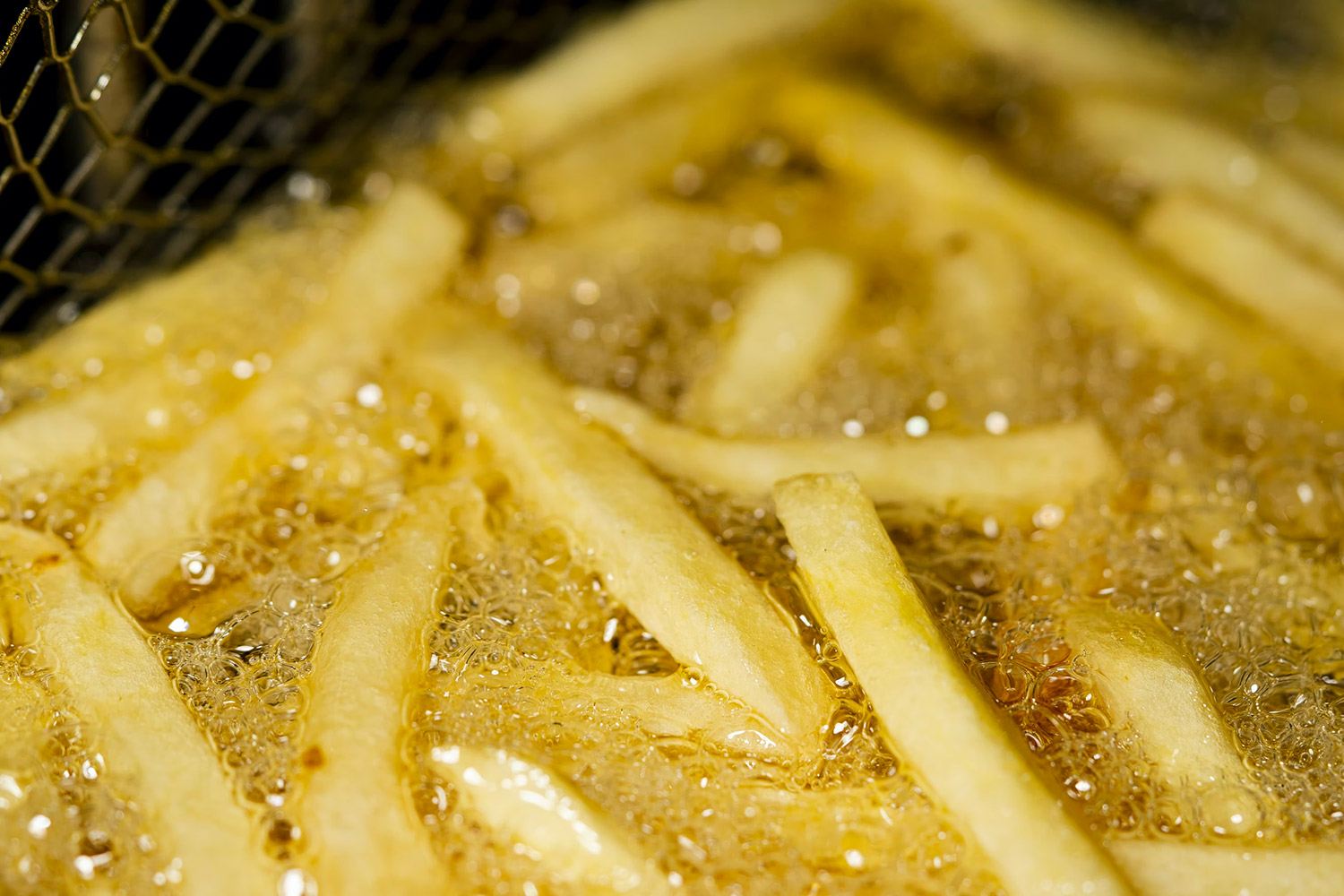
How to properly season homemade fries
Lovers of the golden sticks swear by salt alone. Other seasonings would only distort the inherent flavor of the fries. Personally, however, that would be a bit too boring for me, because the deep-fried delicacies lend themselves wonderfully to experimenting with.
Especially delicious: fried sage, rosemary or dried oregano. These herbs give your fries a special kick and add some color.
Spice ideas for creative fries
- smoked salt
- paprika powder (sweet or hot)
- fried sage (chopped)
- Rosemary (chopped)
- Oregano (chopped)
- Parmesan*
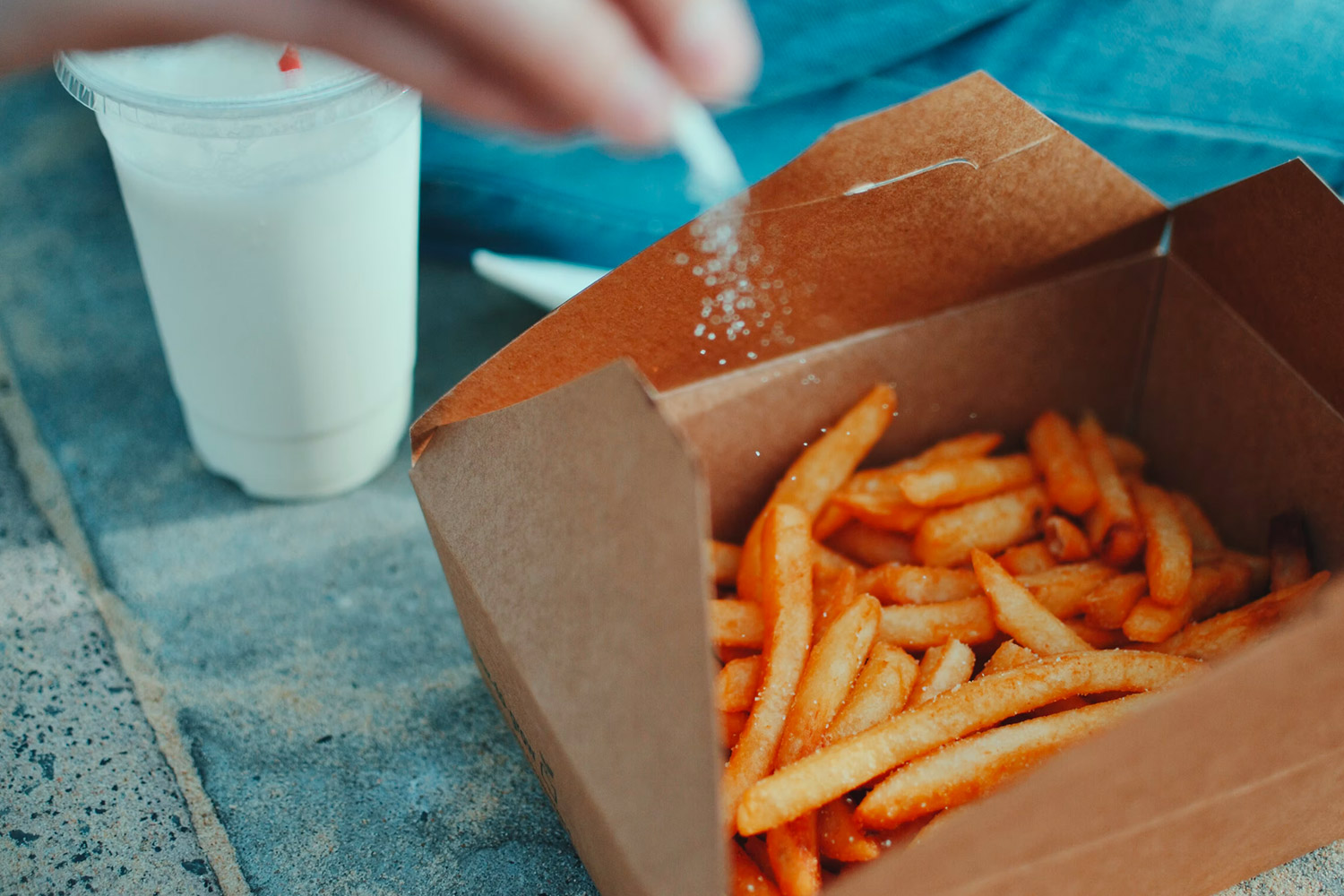
The 6 most common mistakes in the preparation of fries
The fries were fried too hot
If you’ve fried your fries at too high a temperature, the acrylamide content will skyrocket. Make sure the fat is hot, but does not exceed 175 °C.
Your fries are too hard?
If your fries turned golden brown in the fat but are still hard inside, you probably fried them only once. Remember that fries need to be fried twice. First for about 3 minutes at 140 °C, then let them cool briefly and at the end put them again briefly in the fat at 175 °C until they take on a golden brown color. This makes the inside nice and soft and gives the outside a delicious color and crispy crust.
Your fries are too soggy?
Overly soft fries can usually be traced to a mistake in preparation. Did you water your potatoes before preparing them and then dry them off? If not, it’s probably because of that. This is the only way the potato sticks can absorb enough fat to form a nice crust. Another reason would be that your oil temperature is too low. Therefore, always keep an eye on the temperature of the fat and do not put in too many fries at once, otherwise it will cool down quickly. If you have followed all the previous points, you may have fried your fries too short. Give them a few more seconds. Especially in the oven, fries need significantly more time to form a crust.
Your fries break when you deep fry them?
A common problem, which is almost always due to the choice of the wrong variety of potatoes. Floury varieties in particular become brittle during preparation. Be sure to use firm-boiled or predominantly firm-boiled varieties for your fries. A list of suitable varieties can also be found in this article.
Your fries got too dark?
Whether you make your fries in the oven or in the deep fryer, it doesn’t matter. Be sure to pay attention to the temperature and its color in both variants. If they take on a light brownish, rather golden color, your fries are done. Frits that are too dark occur when they are deep-fried / baked for too long or at too high a temperature. The darker your fries, the higher their acrylamide content, which is why you should stop eating them for health reasons.
Your fries are too salty
If you’ve gone a little overboard with the salt, there’s only one way to save salty fries: more fries! Make another batch, add it to the overly salty fries and they’ll absorb the excess salt.
The perfect dip for your homemade fries
French fries without dip are almost impossible to imagine. But instead of the eternal classics of ketchup and mayonnaise, you can dress up your deep-fried fries with sauces that are a little more unusual. Here are a few delicious examples:
- Aioli
- Guacamole
- Truffle mayonnaise
- Wasabi mayonnaise
- Sour cream with fresh herbs
- Green sauce
- Chili Cheese Sauce
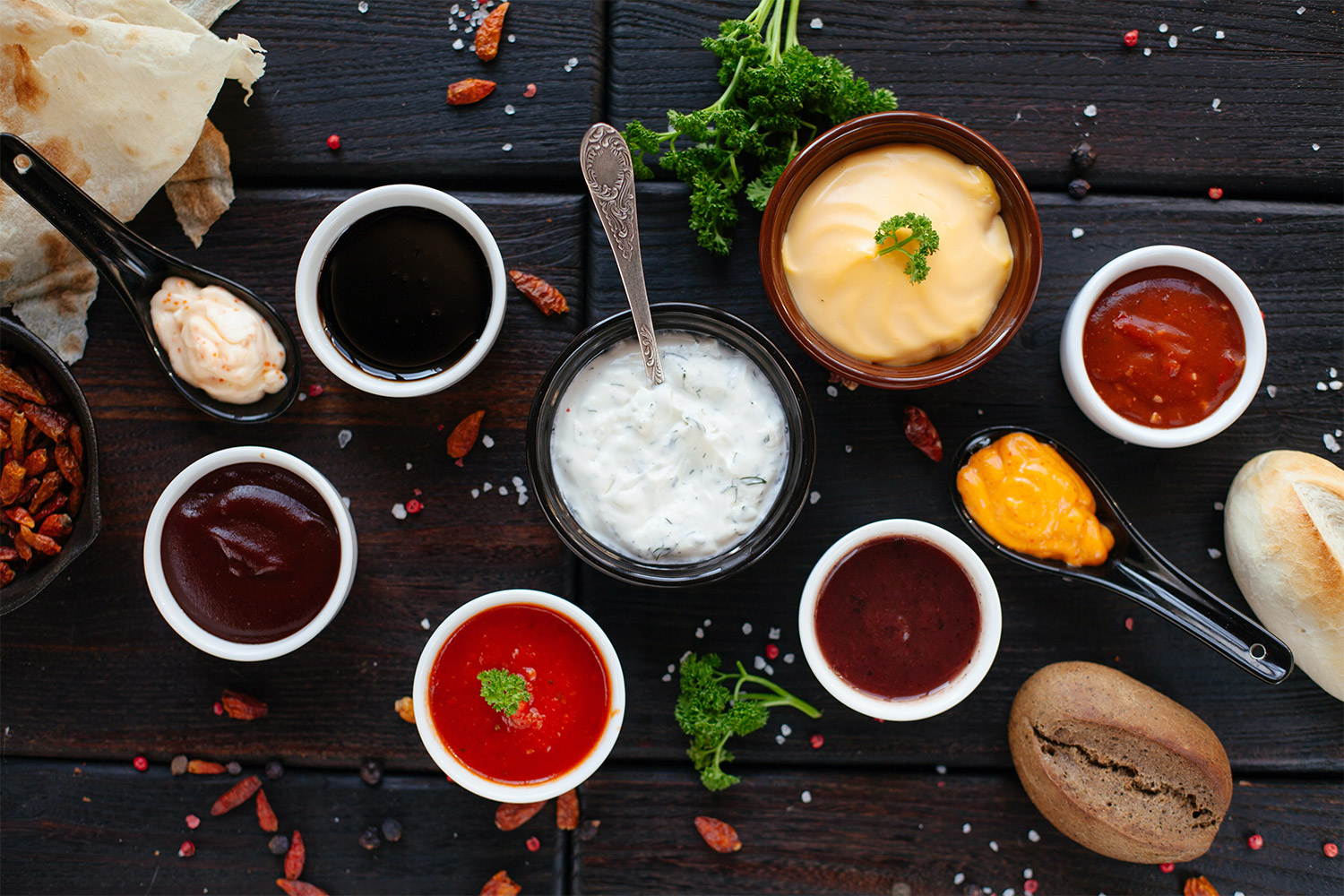
The difference from sweet potato fries
Classic fries are made from potatoes. Sweet potatoes have a similar name, but they are massively different from regular potatoes. For one thing, the two taste fundamentally different. Sweet potato fries have a nutty, slightly sweet flavor. On the other hand, sweet potatoes do not become crispy on their own, but must be sprinkled with a little cornstarch on the outside before baking. However, in terms of nutritional values, both are quite comparable and do not give each other much. With an average of 4.2 g per 100 g, sweet potatoes contain six times as much sugar as normal potatoes.

Champagne – The best wine with fries!
Sounds absurd, because champagne is considered a real luxury item, quite unlike French fries, but the two go together perfectly. Let’s take a closer look at the two: Champagne has a lot of acidity and is sparkling. French fries, on the other hand, contain a lot of fat and salt. So the two are the exact opposite of each other. And as we all know: Opposites attract!
The acid in the champagne helps cut through the fat of the fries, and the salt on the fries in turn softens the acidity of the champagne somewhat. At the same time, the salty nature of the fries enhances the flavors in the sparkling wine. In addition, the subtle yeast notes harmonize perfectly with the potato flavor of the homemade fries. A real match made in Heaven! If you’re more in the mood for a still wine, reach for a dry Sauvignon Blanc.
It doesn’t have to be champagne. A high-quality Crémant, Cava* or a German sparkling wine are equally good companions.
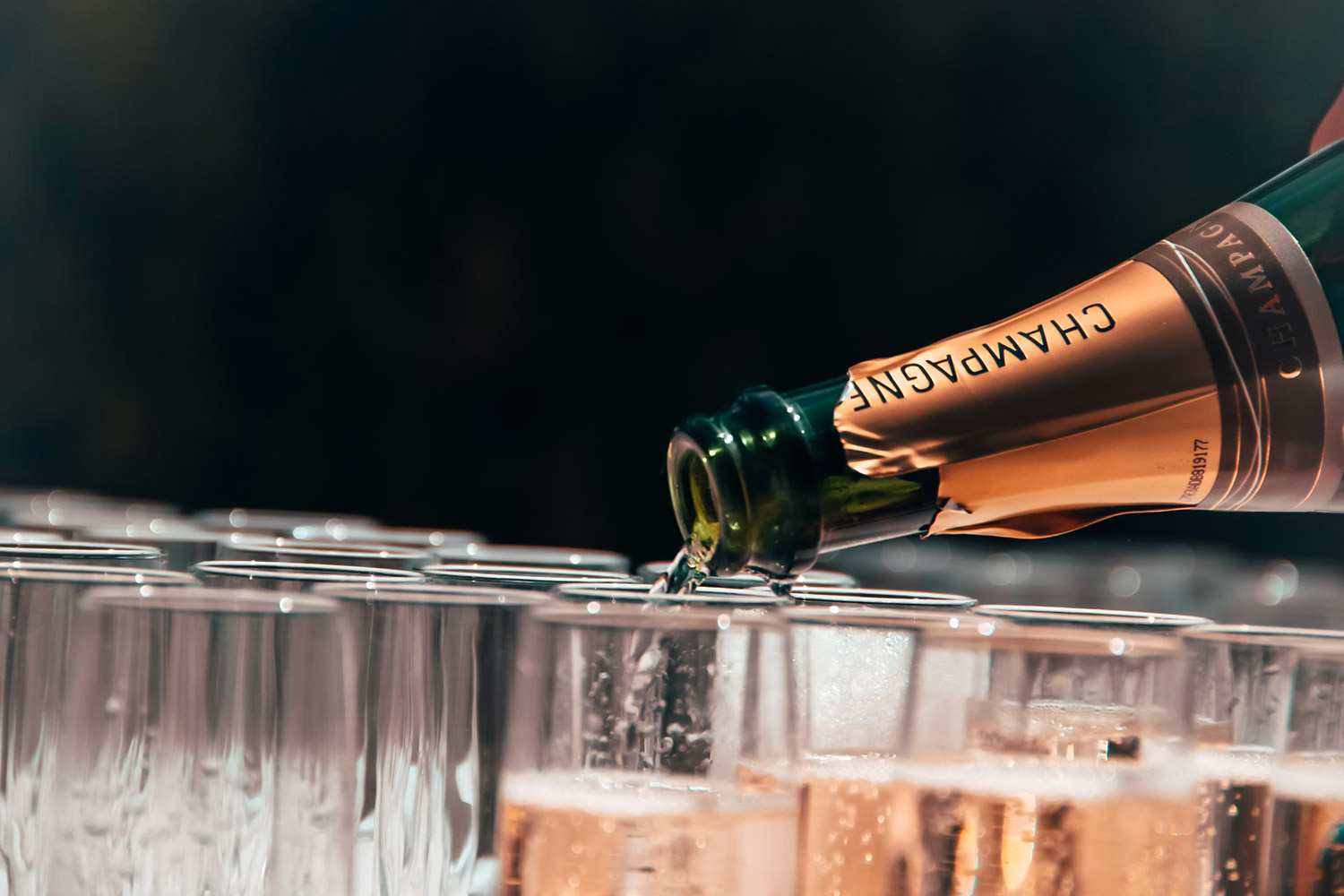
Answers to the most frequently asked questions about homemade fries
- Why double fry?
The first time the fries are fried, they are placed in the oil at a lower temperature (140 to 150 °C) for about three minutes. This ensures that they cook inside. They are then deep-fried again briefly at 175 °C to obtain a golden-brown crust. If fried once, the inside would remain raw, while the outside of the fries would already burn. - Which dip to go with fries?
What you dip your fries in is a matter of faith for some. For many, mayonnaise is a real outrage, but the Belgians swear by it. In the end, whatever tastes good is permitted. In addition to homemade ketchup, you can also reach for creative dips. Try an aioli, guacamole, chili cheese, salsa or a wasabi mayonnaise. - Can fries be reheated?
If you want to reheat cold fries, you should use a hot air fryer or the oven for that. But for them to regain their crispy crust, it needs a little oil. How long your fries take depends on their thickness. In the hot air fryer, they usually only need 3 to 4 minutes until they are delicious and crispy again. - How do fries get really crispy in the oven?
For golden and crispy oven fries you need above all oil and a little patience. Before you put your fries on the baking sheet, you should turn them generously in suitable fat first. Then you should bake them at 200 °C (180 °C convection oven) for 50 minutes. While doing this, keep turning the fries and rotating the baking sheet so they brown evenly. Also, use only waxy potatoes, which better withstand the longer cooking time in the oven. - What fat do you use for fries?
When it comes to fat, you definitely have to pay attention to heat tolerance, i.e. a particularly high smoke point. Sunflower oil or refined rapeseed oil are excellent. Belgium relies almost exclusively on pure beef fat, which gives the fries a meaty and complex flavor. - How to dispose of the old oil?
Let the oil cool and pour it back into the bottle using a funnel. The oil filled in this way is simply disposed of with the residual waste. - Are there gluten-free fries?
French fries are made from potatoes and are therefore naturally gluten-free. However, many ready-to-eat fries are flavored with seasoning blends that may contain grain products. - What is the best French fries seasoning?
Purists swear by salt, nothing else. And in fact, it doesn’t take much more to make perfect fries. If you want to spice it up a bit, add some paprika powder on top. If all that is too boring for you, sprinkle some dry or fresh herbs like rosemary, marjoram, sage and oregano over your fresh fries. The herbs provide a real explosion of flavor. Experimentation is expressly permitted. - How to cut fries correctly?
Simply cut a potato into thick sticks with a knife. To do this, first cut the tubers into 1 to 1.5 centimeter slices, and then again divide them into equal strips. - What is a fry cutter?
A French fry cutter is a kitchen tool that cuts potatoes into evenly thick sticks. If working with a knife is too much work for you or you want to make larger quantities of fries, it may be worth buying one. - What kind of potatoes are suitable for fries?
Almost all (mainly) waxy potato varieties. Floury varieties provide an airy interior, but tend to fall apart during frying. - Is it called the or the fries?
The dictionary knows the answer to this: It is called the French fries. - Why water fries?
Potatoes have a lot of starch, which causes problems when frying. The fries cannot absorb fat, but this is crucial for a crispy crust. For this reason, the raw fries are soaked beforehand so that the starch dissolves and the fries become nice and golden and crispy. - Why are French fries unhealthy?
The acrylamide produced during frying and the high fat content do not exactly make French fries a healthy food. However, the amount of carcinogenic acrylamide can be reduced by controlled temperature. For this reason, your fat should never get hotter than 175°C. The healthiest kind of fries come from a hot air fryer. Here, the temperature can be precisely controlled and only a little fat is needed for a crispy and golden brown crust. - Do fries help against hangovers?
Scientific evidence that greasy food helps against a hangover does not exist. However, the body loses water and minerals through alcohol consumption. This could be one of the reasons why we crave greasy and salty food so much after a night of drinking. However, one thing helps best against a hangover: a big glass of water. - When to salt fries?
Always at the end, right before serving. However, if you prepare your fries in the oven, you can also sprinkle them with salt before baking. However, you should sprinkle more sensitive spices like paprika powder over your fries afterward, as they will burn in the oven. - Can you prepare fries in the microwave?
Actually, the microwave is not suitable for fries. However, many devices have a hot air function. With this fries can be prepared as in the oven.
